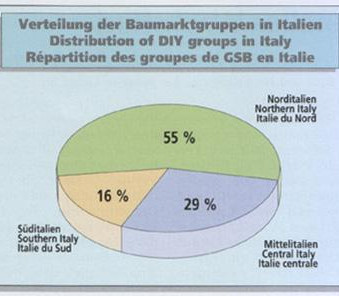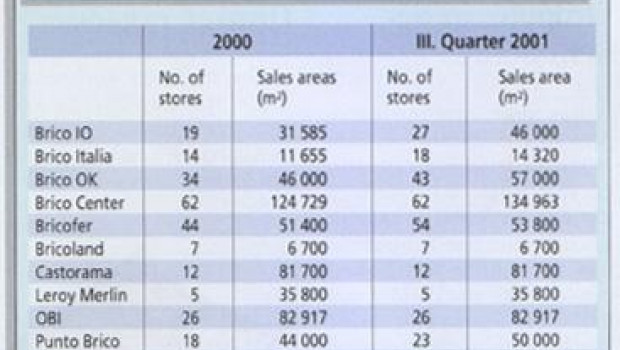The Italians channel 30 per cent of their total expenditure into a home of their own. It is the smaller DIY stores above all that profit from this tendency, and their number is steadily growing
When the different regions are looked at individually it becomes clear that there is an increased willingness to spend, especially in northern Italy (+ 8.3 per cent), whereas growth of 5.7 per cent was recorded in central Italy and 7.1 per cent in the south. Substantially more (32 per cent) is spent in the north than in the south.
What do Italians spend their money on? In southern Italy expenditure is still linked to the consumption of food, whereas distinctions are made according to categories like home and leisure in northern and central Italy. Their homes occupy top position in the hearts and purses of the Italians, accounting for 29.7 per cent of total expenditure (2000), which indicates growth of 1.2 percentage points compared with the previous survey completed in 1997. A home in the narrower sense gives rise to monthly costs (rent, loans, renovations, etc.) to the tune of 486 euro, added to which come expenditure of 161 euro on furniture, electrical appliances and services, giving total outgoings of 647 euro (1997: 586 euro).
The builders’ merchants and DIY superstores, which managed to notch up significant growth in the year 2001, also profit from this development. The first nine months of 2001 saw the opening of 30 new stores, corresponding to growth of 11.5 per cent. Brico IO was able to increase its number of stores by eight to 27, all of them stores forfeited by Self. Bricofer added on ten new stores, which increased its total to 54. Brico IO succeeded in chalking up a gain of nine stores to 44 overall. Punto Brico acquired five locations and Brico Italia four.
The growth of retail area was less significant, with an increase of 6.6 per cent to 597 000 m². This is a reflection of the trend towards smaller-format outlets, which has left its mark on the retail landscape over the last few years.
Independent retailers are being faced with the decision either to close their business down or to join a cooperative or buying organisation. As a rule their shops have a floorspace that seldom exceeds between 1 500 and 2 000 m² in size. One example of this type is provided by Bricofer, which achieves a total retail area of 54 000 m² with 54 stores. Totally in contrast to the Italian DIY chain Bricocenter, with 62 stores and a retail area of approx. 135 000 m², or the French Castorama group, which achieves an area of 82 000 m² with only twelve stores.
How are the DIY stores distributed across Italy? The majority of DIY stores are in northern Italy, which is where more than 55 per cent of stores are located. There are 29 per cent in central Italy and just 16 per cent in southern Italy. However, this only reflects the distribution of the DIY chains in Italy, not the actual interest shown by consumers in do-it-yourself. DIY is popular in southern Italy, where many shops carry a product offer that ranges from hardware to self-assembly furniture, and from tools to garden furniture. These shops are very well known and include Capaldo in Campania and Scalia in Sicily, for example.
DIY in Europe 1-2/2002














